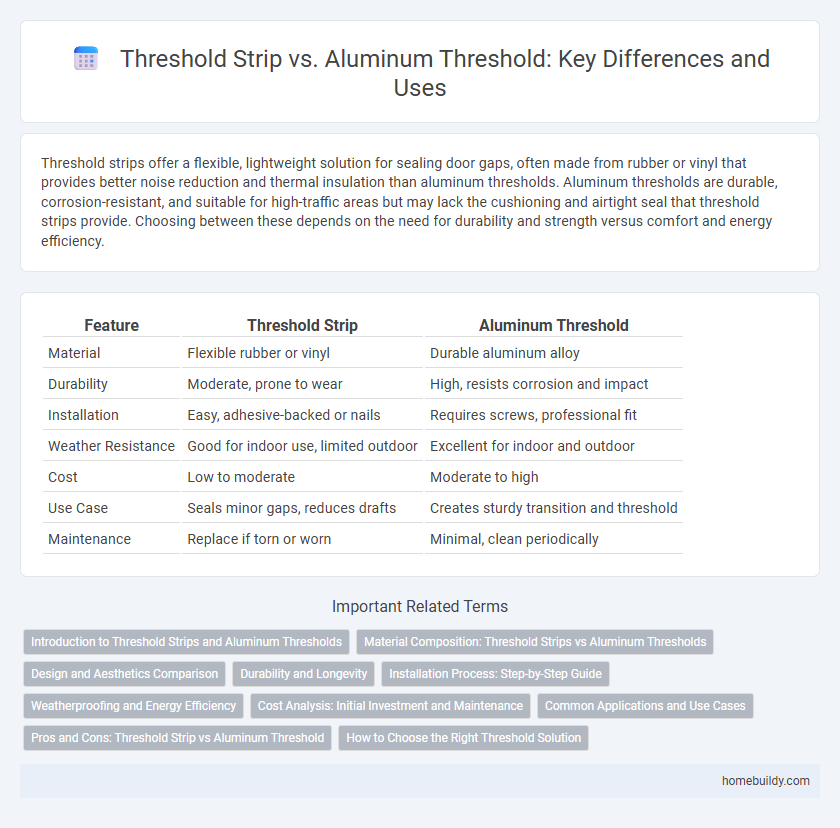Threshold strips offer a flexible, lightweight solution for sealing door gaps, often made from rubber or vinyl that provides better noise reduction and thermal insulation than aluminum thresholds. Aluminum thresholds are durable, corrosion-resistant, and suitable for high-traffic areas but may lack the cushioning and airtight seal that threshold strips provide. Choosing between these depends on the need for durability and strength versus comfort and energy efficiency.
Table of Comparison
| Feature | Threshold Strip | Aluminum Threshold |
|---|---|---|
| Material | Flexible rubber or vinyl | Durable aluminum alloy |
| Durability | Moderate, prone to wear | High, resists corrosion and impact |
| Installation | Easy, adhesive-backed or nails | Requires screws, professional fit |
| Weather Resistance | Good for indoor use, limited outdoor | Excellent for indoor and outdoor |
| Cost | Low to moderate | Moderate to high |
| Use Case | Seals minor gaps, reduces drafts | Creates sturdy transition and threshold |
| Maintenance | Replace if torn or worn | Minimal, clean periodically |
Introduction to Threshold Strips and Aluminum Thresholds
Threshold strips provide a versatile solution for bridging gaps between different flooring types, enhancing floor transition durability and improving sound insulation. Aluminum thresholds offer a robust, corrosion-resistant option with sleek design appeal, commonly used in commercial and high-traffic areas for their lightweight strength. Both products serve as essential components in doorways, but aluminum thresholds excel in longevity and structural support compared to standard threshold strips.
Material Composition: Threshold Strips vs Aluminum Thresholds
Threshold strips are typically made from materials such as rubber, vinyl, or wood, offering flexibility and cushioning for doorways, while aluminum thresholds consist of lightweight, corrosion-resistant metal designed for durability and strength. The material composition of threshold strips provides enhanced noise reduction and weather sealing properties, contrasting with aluminum thresholds' superior structural support and long-term wear resistance. Choosing between the two depends on the balance of material flexibility, durability, and specific environmental exposure requirements.
Design and Aesthetics Comparison
Threshold strips offer a variety of design options with materials like rubber, vinyl, and wood, allowing for seamless integration with different flooring styles and interior decors, enhancing overall aesthetics. Aluminum thresholds provide a sleek, modern look with their metallic finish and clean lines, ideal for contemporary spaces requiring durability and minimal maintenance. While aluminum thresholds emphasize functionality and a minimalist design, threshold strips prioritize versatility and adaptability to match diverse design preferences.
Durability and Longevity
Threshold strips made from vinyl or rubber often provide better flexibility and resistance to wear but may degrade faster under extreme weather conditions compared to aluminum thresholds. Aluminum thresholds offer superior durability and longevity due to corrosion resistance and higher strength, making them ideal for high-traffic or outdoor entrances. Choosing between a threshold strip and an aluminum threshold depends on the balance between cost, environmental exposure, and the desired lifespan of the installation.
Installation Process: Step-by-Step Guide
The installation process for a threshold strip typically involves measuring the doorway, cutting the strip to size, and securing it with screws or adhesive for a snug fit. Aluminum thresholds require precise measurement and often drilling into the floor or threshold surface to anchor with screws, ensuring durability and stability. Both methods demand careful alignment and surface preparation to prevent gaps and ensure effective sealing against drafts and moisture.
Weatherproofing and Energy Efficiency
Threshold strips with integrated weatherproofing seals offer superior protection against drafts, moisture, and dust, enhancing the overall energy efficiency of a building by minimizing heat loss. Aluminum thresholds, while durable and lightweight, often require additional weatherstripping to achieve comparable insulation performance and resistance to water infiltration. The choice between threshold strips and aluminum thresholds significantly impacts thermal bridging and air sealing, directly influencing heating and cooling costs.
Cost Analysis: Initial Investment and Maintenance
Threshold strips generally have a lower initial investment compared to aluminum thresholds, making them a cost-effective choice for budget-conscious projects. Maintenance costs for threshold strips are typically minimal due to their flexibility and resistance to wear, whereas aluminum thresholds may incur higher upkeep expenses from corrosion and dent repairs. Choosing a threshold strip can reduce overall expenditure through both affordable initial pricing and long-term durability.
Common Applications and Use Cases
Threshold strips are commonly used in residential interiors to provide a smooth transition between different flooring types, reduce drafts, and improve energy efficiency. Aluminum thresholds are preferred in commercial and industrial settings due to their durability, resistance to heavy foot traffic, and weatherproof qualities, making them suitable for exterior doorways and high-traffic entrances. Both solutions serve to enhance safety by reducing trip hazards and protecting floor edges, with the choice depending on environment and load requirements.
Pros and Cons: Threshold Strip vs Aluminum Threshold
Threshold strips offer enhanced flexibility and easier installation on uneven floors, making them ideal for interior doorways and low-traffic areas. Aluminum thresholds provide superior durability, weather resistance, and strength, suitable for exterior entrances exposed to heavy foot traffic and harsh conditions. While threshold strips may wear out faster and require more frequent replacement, aluminum thresholds often involve higher initial costs but deliver long-term performance with minimal maintenance.
How to Choose the Right Threshold Solution
Selecting the right threshold solution depends on factors like durability, installation environment, and aesthetic preferences. Threshold strips are often made from flexible materials like rubber or vinyl, providing excellent sealing and noise reduction, ideal for interior doorways. Aluminum thresholds offer superior strength and weather resistance, making them suitable for exterior doors exposed to heavy foot traffic and harsh weather conditions.
Threshold strip vs Aluminum threshold Infographic

 homebuildy.com
homebuildy.com